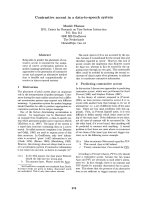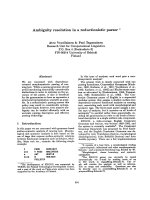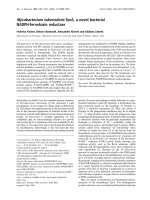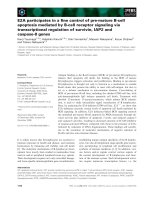Báo cáo sinh học: " Genital tuberculosis in a tamoxifen-treated postmenopausal woman with breast cancer and bloody vaginal discharge" pot
Bạn đang xem bản rút gọn của tài liệu. Xem và tải ngay bản đầy đủ của tài liệu tại đây (218.17 KB, 4 trang )
BioMed Central
Page 1 of 4
(page number not for citation purposes)
Annals of Clinical Microbiology and
Antimicrobials
Open Access
Case report
Genital tuberculosis in a tamoxifen-treated postmenopausal
woman with breast cancer and bloody vaginal discharge
Ioannis Neonakis
1
, Elpis Mantadakis
2
, Zoe Gitti
1
, Ioanna Mitrouska
3
,
Louis George Manidakis
4
, Sofia Maraki
1
and George Samonis*
2
Address:
1
Laboratory of Mycobacteriology, Department of Clinical Bacteriology, Parasitology, Zoonoses, and Geographical Medicine, University
Hospital of Heraklion, 712 01 Heraklion, Crete, Greece,
2
Department of Internal Medicine, University Hospital of Heraklion, 712 01 Heraklion,
Crete, Greece,
3
Department of Thoracic Medicine, University Hospital of Heraklion, 712 01 Heraklion, Crete, Greece and
4
Department of
Obstetrics and Gynecology, University Hospital of Heraklion, Heraklion, Crete, Greece
Email: Ioannis Neonakis - ; Elpis Mantadakis - ; Zoe Gitti - ;
Ioanna Mitrouska - ; Louis George Manidakis - ; Sofia Maraki - ;
George Samonis* -
* Corresponding author
Abstract
Background: Female genital tuberculosis is an uncommon disease that is rarely diagnosed in
developed countries.
Case presentation: A 61-year-old postmenopausal woman who had undergone surgery and
treated with adjuvant chemotherapy for infiltrating ductal carcinoma of the breast five years ago,
presented with bloody vaginal discharge, fatigue, weight loss, and low grade fevers at night for two
months. Histological examination of the endometrium, done based on the suspicion of a second
primary cancer due to the tamoxifen therapy, revealed a granulomatous reaction. Liquid and solid
mycobacterial cultures of the tissues were performed. Although the acid fast staining was negative,
the liquid culture was positive for Mycobacterium tuberculosis. Involvement of other systems was not
detected. The patient was treated with a three-drug antituberculosis regimen for 9 months and
recovered fully.
Conclusion: Female genital tuberculosis is a rare but curable disease that should be included in
the differential diagnosis of women with menstrual problems. Early diagnosis is important and may
prevent unnecessary invasive procedures for the patient.
Background
Tuberculosis (TB) predominately presents with pulmo-
nary disease, although extra-pulmonary TB is not uncom-
mon [1-4]. Diagnosis of extra-pulmonary TB is often
difficult, because of its non-specific clinical and labora-
tory findings [2]. Female genital TB (FGTB) is usually a
symptom-less disease diagnosed during investigations for
infertility [5-7]. Symptomatic disease usually presents
with pelvic pain or menstrual irregularities [8,9]. FGTB is
extremely rare in postmenopausal women [10]. We
present a case of FGTB in a tamoxifen-treated postmeno-
pausal woman with breast cancer and bloody vaginal dis-
charge.
Published: 01 September 2006
Annals of Clinical Microbiology and Antimicrobials 2006, 5:20 doi:10.1186/1476-0711-5-
20
Received: 05 July 2006
Accepted: 01 September 2006
This article is available from: />© 2006 Neonakis et al; licensee BioMed Central Ltd.
This is an Open Access article distributed under the terms of the Creative Commons Attribution License ( />),
which permits unrestricted use, distribution, and reproduction in any medium, provided the original work is properly cited.
Annals of Clinical Microbiology and Antimicrobials 2006, 5:20 />Page 2 of 4
(page number not for citation purposes)
Case presentation
A 61-year-old postmenopausal woman diagnosed in the
past with breast cancer presented to her Oncologist for
regular follow up. The patient complained of fatigue,
weight loss, persistent slight evening pyrexia, a mild lower
abdominal pain for the last two months, along with leuk-
orrhea and bloody vaginal discharge for the last three
weeks. Five years ago, during the perimenopausal period,
she was diagnosed with an infiltrating ductal carcinoma
of the breast. She underwent lumpectomy followed by
adjuvant chemotherapy and radiotherapy. Since then she
was receiving oral tamoxifen that she was due to stop in
one month and had no clinical, laboratory or radiological
evidence of recurrent or metastatic disease.
Physical examination revealed mild abdominal disten-
sion and an enlarged, tense, and tender uterus. A chest
radiograph was negative, while a full blood count, serum
electrolytes, and liver function tests were normal. A trans-
vaginal ultrasonogram showed an enlarged uterus with a
7 mm endometrial thickness (normal for age up to 4
mm). Hysteroscopy and endometrial aspiration biopsy
performed because of the suspicion of a second primary
cancer of the endometrium from the tamoxifen therapy
disclosed necrotic debris with an extensive granuloma-
tous reaction, numerous tubercles composed of epithe-
lioid cells, and multinucleated giant cells with no central
necrosis. These findings raised the suspicion of FGTB.
Hence, samples from the endocervix and the
endometrium were obtained with the use of a sterile Cyto
Brush for PAP smear, suspended in sterile water, and proc-
essed according to standard guidelines [11] followed by
cultures in solid (Lowenstein-Jensen, BioMerieux, France)
and liquid media (BacT/Alert 3D, Organon Teknika, NC).
Although acid-fast staining was negative, the liquid cul-
ture gave a positive signal after 7 days of incubation. The
presence of Mycobacterium tuberculosis was verified by
AccuProbe assay (Gen-Probe, CA) and phenotypic-bio-
chemical analysis. Since the samples submitted for culture
from the endocervix and the endometrium were not sepa-
rated, it is unclear if TB was limited to the endocervix, the
endometrium or both.
Tuberculin skin testing was positive (>15 mm), while
detailed family history revealed that the patient's mother
and sister had died 30 and 10 years ago from TB. The
patient had taken close care of both. No other family
members had symptoms suspicious of TB. Interestingly,
the patient had refused this family history at presentation
to her Oncologist. Finally, she admitted the contact his-
tory to patients infected with TB only after the results of
the cultures were available. In order to rule out pulmonary
and renal spread of the disease, imaging and laboratory
evaluation with chest radiograph and examination of
multiple early morning sputum and urine samples with
acid-fast staining and cultures was performed and showed
no lung or renal involvement.
Drug susceptibility testing was performed by the propor-
tional methods on Lowenstein-Jensen medium. The iso-
lated strain was resistant to pyrazinamide (200 μg/ml),
streptomycin (4 μg/ml), ethionamide (30 μ g/ml),
rifampicin (20 μg/ml) and pefloxacine (25 μg/ml) and
susceptible to isoniazid (0.2 μg/ml), rifampicin (40 μg/
ml), ethambutol (2 μg/ml), streptomycin (10 μg/ml) and
para-4-aminosalicylic acid (0.5 μ g/ml). The patient was
treated with a three-drug regimen of isoniazid (300 mg/
day), rifampicin (600 mg/day) and ethambutol (1500
mg/day) for nine months. Within a month after the begin-
ning of antituberculosis therapy, the vaginal discharge dis-
appeared along with resolution of the fatigue, a two
kilogram weight gain, and complete resolution of the per-
sistent evening pyrexia and the lower abdominal pain.
Discussion
Despite the remarkable efforts to control TB worldwide
over the past decades, almost two million people still die
of this disease every year, justifying the declaration of TB
as a public health emergency by the 44
th
World Health
Assembly. FGTB is an uncommon presentation. Its exact
incidence remains unknown, as the majority of the cases
remain undiagnosed. In Western countries the incidence
of FGTB is estimated to be <1%, whereas in some African
and Asian countries it reaches 15–19% [12,13].
Although in some cases cervical TB is thought to be the
primary infection [14,15], FGTB is usually a secondary
complication of pulmonary TB. In most cases it begins
with a focus in the endosalpinx and spreads to the
endometrium, the ovaries, occasionally to the cervix and
rarely the vagina [8]. In our case it is unclear whether the
disease was limited to the endocervix and/or the
endometrium since the samples provided for culture were
not separated.
In the developing world, almost nine out of ten cases are
young women between 20 and 40 years of age [16],
whereas, in Western countries it is usually diagnosed in
women over the age of 40, usually pre-menopausal ones
[17-19]. The atrophic endometrium of postmenopausal
women is thought to offer a poor milieu for the growth of
M. tuberculosis [10]. Hence, in contrast to premenopausal
women where infertility is the main symptom leading the
suspected gynecologist to seek for FGTB, in postmenopau-
sal women vaginal bleeding is the usual presenting symp-
tom of the disease.
FGTB is rarely diagnosed in developed countries. Symp-
toms are usually absent and there is often no evidence of
TB in other organs. If present, the symptoms are mild and
Annals of Clinical Microbiology and Antimicrobials 2006, 5:20 />Page 3 of 4
(page number not for citation purposes)
local, such as abdominal pain or menstrual irregularities.
Infertility is the most common consequence [7]. Due to its
rarity and its mild clinical picture, the index of suspicion
for the diagnosis of FGTB among gynecologists is usually
low. This is unfortunate since early detection and proper
treatment can, in some cases, prevent irreversible damage
to the fallopian tubes and the endometrium. Once fibro-
sis is established, fertility is generally difficult to restore
even with appropriate treatment [9]. Nevertheless, early
diagnosis can save the patient from a series of invasive
diagnostic or therapeutic procedures. To this end, identi-
fication of high risk patients is helpful. Suspicions should
be raised if a woman has a personal history of latent tuber-
culous infection or previous contact with persons suffer-
ing from TB. In the present case, persistent questioning
revealed the patient's prior close contact with infected per-
sons. Furthermore, the clinician should be suspicious if
the patient originates from areas where TB or AIDS are
endemic, since more than 3% of new cases of TB are
related to HIV infection [13]. Additionally, in some devel-
oping countries, as much as 60–90% of extrapulmonary
TB occurs in HIV positive patients [13,20]. Since genital
disease often causes no physical symptoms, infertile
women should be examined for TB, especially in case of
predisposing factors. This is also true for post-menopausal
women with vaginal bleeding. Samples from the
endometrium and the endocervix should be submitted for
cytological examination, acid fast stains, and cultures,
since combination of different methods is likely to have a
higher diagnostic yield for TB.
The diagnostic role of a positive Mantoux (purified pro-
tein derivative-PPD) skin test is controversial. In a recent
study, almost 45% of infertile women with strong indirect
evidence of pelvic TB, such as laparoscopic findings
(thickened tubes, areas of caseation, etc.), had a negative
PPD skin test [21]. On the other hand, in a group of 27
infertile women with a positive PPD skin test, only 11 had
clear laparoscopic findings suggestive of FGTB. The other
conventional diagnostic methods of TB, such as chest
radiographs, urine, and sputum cultures are not specific
for FGTB, but are helpful to rule out dissemination to
other organs. Infertile women with a positive PPD skin
test should undergo early laparoscopy for direct visualiza-
tion of the fallopian tubes and for collection of material
from the pelvis for pathological examination and cultures
[21]. Laparoscopic findings, such as the presence of exces-
sive peritoneal fluid, rigid and almost immobile tubes,
presence of tubercles or caseous material are indicative
but not pathognomonic of FGTB. The value of other diag-
nostic means, such as sonography or hysterosalpingogra-
phy remains controversial [19].
Histological detection of typical granulomata is sufficient
for diagnosis of pelvic TB, providing that all other causes
of granulomatous reactions have been ruled out. Differen-
tial diagnosis includes tularemia, sarcoidosis, brucellosis,
amoebiasis, schistosomiasis and foreign body reactions
[9,22]. Identification of extragenital TB strongly supports
the diagnosis. Nevertheless, the gold standard for diagno-
sis of FGTB is the isolation of M. tuberculosis from appro-
priate specimens, usually biopsy materials from the
endometrium. Samples can be used for the detection of
M. tuberculosis DNA by PCR or can be cultured [16].
Efforts are currently made to use menstrual blood, when
available, for molecular or serological diagnosis [16].
In the present case, the differential diagnosis included a
second primary cancer of the endometrium due to the
prolonged use of tamoxifen and possible genital TB or
other granulomatous diseases. The use of a Cyto Brush
was effective for proper sample taking, while isolation of
M. tuberculosis was achieved by conventional methods.
The use of Cyto Brush has some advantages compared
with biopsy, such as simplicity, ease of use, low cost, and
minimal patient discomfort. To our knowledge, no stud-
ies have directly compared biopsy versus Cyto Brush or
Cyto Brush versus other conventional sampling methods,
e.g., wooden spatulas or cotton swabs for isolation of
mycobacteria, although the hydrophobic nature of the
lipid-containing cell wall of mycobacteria inhibits their
transfer from the cotton fibers to the aqueous culture
medium [23].
Acid-fast staining was negative in our patient. This test is
infrequently positive, since approximately 10
5
mycobacte-
ria per milliliter are required in order to have a positive
result [19]. On the other hand, liquid mycobacterial cul-
tures are useful, usually leading to isolation within days.
Nowadays, a series of automatic liquid culture systems are
available contributing to faster diagnosis.
In conclusion, FGTB is a rare but curable disease that
should be included in the differential diagnosis of post-
menopausal vaginal bleeding. Early diagnosis is impor-
tant and it can save the patient from unnecessary invasive
procedures.
Abbreviations
TB: tuberculosis, FGTB: Female genital tuberculosis, PPD:
purified protein derivative
Competing interests
The author(s) declare that they have no competing inter-
ests.
Authors' contributions
IN carried out the laboratory procedures and drafted the
paper. EM helped to draft the manuscript and revised it
critically. ZG participated in carrying out the laboratory
Publish with BioMed Central and every
scientist can read your work free of charge
"BioMed Central will be the most significant development for
disseminating the results of biomedical research in our lifetime."
Sir Paul Nurse, Cancer Research UK
Your research papers will be:
available free of charge to the entire biomedical community
peer reviewed and published immediately upon acceptance
cited in PubMed and archived on PubMed Central
yours — you keep the copyright
Submit your manuscript here:
/>BioMedcentral
Annals of Clinical Microbiology and Antimicrobials 2006, 5:20 />Page 4 of 4
(page number not for citation purposes)
procedures. IM handled the patient's antituberculosis
treatment. LGM performed the hysteroscopy and
endometrial aspiration biopsy of the patient. SM partici-
pated in the coordination of the clinical and laboratory
work-up. GS conceived the report, treated the patient for
the breast cancer, revised the manuscript and gave final
approval of the submitted version. All authors have read
and approved the final manuscript.
Acknowledgements
Written consent was obtained from the patient for publication of the study.
References
1. Gonzalez OY, Adams G, Teeter LD, Bui TT, Musser JM, Graviss EA:
Extra-pulmonary manifestations in a large metropolitan
area with a low incidence of tuberculosis. Int J Tuberc Lung Dis
2003, 7:1178-1185.
2. Rasolofo RV, Menard D, Auregan G, Gicquel B, Chanteau S:
Extrapulmonary and pulmonary tuberculosis in Antanan-
arivo (Madagascar): high clustering rate in female patients. J
Clin Microbiol 2002, 40:3964-3969.
3. Harries AD, Hargreaves NJ, Kwanjana JH, Salaniponi FM: The diag-
nosis of extrapulmonary tuberculosis in Malawi. Trop Doct
2003, 33:7-11.
4. Lewis KE, Stephens C, Shahidi MM, Packe G: Delay in starting
treatment for tuberculosis in east London. Commun Dis Public
Health 2003, 6:133-138.
5. Goldin AG, Baker WT: Tuberculosis of the female genital tract.
J Ky Med Assoc 1985, 83:75-76.
6. Margolis K, Wranz PA, Kruger TF, Joubert JJ, Odendaal HJ: Genital
tuberculosis at Tygerberg Hospital – prevalence, clinical
presentation and diagnosis. S Afr Med J 1992, 81:12-15.
7. Namavar Jahromi B, Parsanezhad ME, Ghane-Shirazi R: Female gen-
ital tuberculosis and infertility. Int J Gynaecol Obstet 2001,
75:269-272.
8. Haas DW, Des Prez RM: Mycobacterium Tuberculosis. In Princi-
ples and Practice of Infectious Diseases Edited by: Mandell GL, Bennett
JE, Dolin R. Philadelphia, Churchill Livingstone; 1995:2238.
9. Lamba H, Byrne M, Goldin R, Jenkins C: Tuberculosis of the cer-
vix: case presentation and a review of the literature. Sex
Transm Infect 2002, 78:62-63.
10. Maestre MA, Manzano CD, Lopez RM: Postmenopausal endome-
trial tuberculosis. Int J Gynaecol Obstet 2004, 86:405-406.
11. Kubica GP, Gross WM, Hawkins JE, Sommers HM, Vestal AL, Wayne
LG: Laboratory services for mycobacterial diseases. Am Rev
Respir Dis 1975, 112:773-787.
12. Punnonen R, Kiilholma P, Meurman L:
Female genital tuberculosis
and consequent infertility. Int J Fertil 1983, 28:235-238.
13. Giannacopoulos KCh, Hatzidaki EG, Papanicolaou NC, Relakis KJ,
Kokori HG, Giannacopoulou CC: Genital tuberculosis in a HIV
infected woman: a case report. Eur J Obstet Gynecol Reprod Biol
1998, 80:227-229.
14. Sutherland AM, Glen ES, MacFarlane JR: Transmission of genito-
urinary tuberculosis. Health Bull (Edinb) 1982, 40:87-91.
15. Richards MJ, Angus D: Possible sexual transmission of geni-
tourinary tuberculosis. Int J Tuberc Lung Dis 1998, 2:439.
16. Abebe M, Lakew M, Kidane D, Lakew Z, Kiros K, Harboe M: Female
genital tuberculosis in Ethiopia. Int J Gynaecol Obstet 2004,
84:241-246.
17. Falk V, Ludviksson K, Agren G: Genital tuberculosis in women.
Analysis of 187 newly diagnosed cases from 47 Swedish hos-
pitals during the ten-year period 1968 to 1977. Am J Obstet
Gynecol 1980, 138:974-947.
18. Manidakis LG, Angelakis E, Sifakis S, Stefanaki P, Kalogeraki A, Mani-
daki A, Koumantakis E: Genital tuberculosis can present as dis-
seminated ovarian carcinoma with ascites and raised Ca-
125: a case report. Gynecol Obstet Invest 2001, 51:277-279.
19. Chow TW, Lim BK, Vallipuram S: The masquerades of female
pelvic tuberculosis: case reports and review of literature on
clinical presentations and diagnosis. J Obstet Gynaecol Res 2002,
28:203-210.
20. Narain JP, Raviglione MC, Kochi A: HIV-associated tuberculosis
in developing countries: epidemiology and strategies for pre-
vention. Tuber Lung Dis 1992, 73:311-321.
21. Raut VS, Mahashur AA, Sheth SS: The Mantoux test in the diag-
nosis of genital tuberculosis in women. Int J Gynaecol Obstet
2001, 72:165-169.
22. Koller AB: Granulomatous lesions of the cervix uteri in Black
patients. S Afr Med J 1975, 49:1228-32.
23. Koneman E, Allen S, Janda W, Schreckenberger P, Winn W:
Myco-
bacteria. In Colour atlas and textbook of Diagnostic Microbiology Edited
by: Koneman E, Allen S, Janda W, Schreckenberger P, Winn W. Phil-
adelphia, Lippincott; 1997:898.









